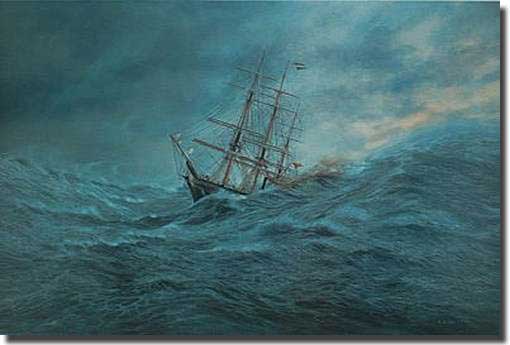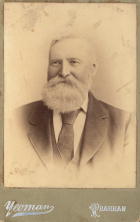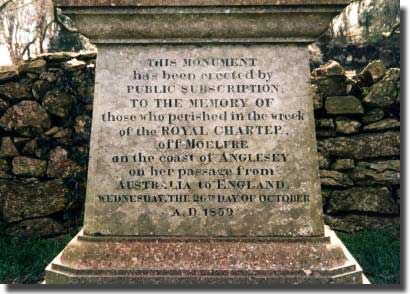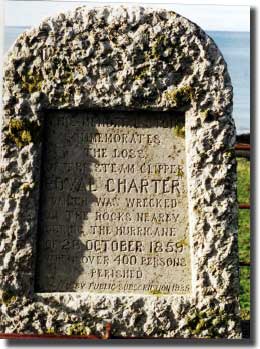|
The Golden Shipwreck. Steam Clipper Royal Charter comes to grief
(see the letter about the search for Manus Boyle and the letter about finding him) The Royal Charter was a 2,719 ton steam clipper, fitted with a 200 horse power auxiliary engine. George Cramm laid down the Royal Charter, ordered by Charles Moore and Company of Liverpool, launching her on the River Dee in 1855. Gibbs Bright and Company bought her in an unfinished state, taking over the hull of this iron sailing ship after her original builder failed, and went bankrupt. William Patterson now completed the vessel to the new owner's specifications, the ship destined for the Australian run. Made from steel with clipper lines, the engine was added to avoid the ship becoming becalmed in the Doldrums, and designed to carry up to 600 passengers, but with a limited cargo capacity. Royal Charter was the fastest ship plying the route between Liverpool and Australia, usually making the trip in under 60 days.
The 26th. of August in 1859 found the ship clearing Hobson's Bay, Victoria, Australia, and setting a course for Liverpool via Cape Horn. Captain Taylor in command, with 400 passengers, and carrying a precious cargo of gold from the newly found goldfields of the Colony, with a value of half a million Pounds Sterling, anticipated a fast run home to Liverpool. Close to Cape Horn an iceberg was narrowly avoided, and by the 24th. of October, the ship was anchored some 20 miles off the port of Cork in Ireland. Course was set for Liverpool, and with night fast falling, the wind was freshening, to quickly develop into a full gale, which fell with great fury upon the ship. Off the Skerries, Captain Taylor called for a Pilot, to no avail, again he asked for a Pilot off Point Lynas, but no pilot boat was forthcoming, it was far too rough for any small boat to venture out into the gale force winds and wild seas. By 2300 ( 11 PM ) the storm threatened the safety of Royal Charter, the port anchor was let go, and 100 fathoms of cable paid out, this was quickly followed by letting go the starboard anchor with 70 fathoms of cable, for some time the two anchors steadied the vessel. But at 0130 ( 1.30 AM ) the port cable suddenly parted, to be quickly followed by the starboard cable also parting. The vessel soon grounded, with the coming of dawn about 0530 ( 5.30 AM ) the wreck was seen on shore by Thomas Hughes and Mesech Williams who were absolutely helpless to do anything but watch the ship being pounded to pieces.
Through the efforts of Rogers and men from Moelfre forming a human chain in the raging seas, 18 of 376 passengers, 5 of 11 riggers working their passage home, 18 of more than 100 crew, but no officers, were saved.
Jack Russell These 28 local men who valiantly went to the rescue at great danger to themselves are not recorded on any monument, but I list them here:
St Gallgos, the village church became a makeshift morgue as the bodies of many of the victims were brought ashore from the sea. The Rector of Llaneugred and Llanallgo, the Reverend Stephen Roose Hughes and his brother, the Reverend Hugh Robert Hughes, buried many of the victims, the former going to meticulous lengths to record everything he could about each body, including the contents of their pockets, he also wrote some 1,075 letters to answer queries of the relatives of the victims.
The subsequent strain of it all brought an early death to Stephen Roose Hughes, he now lies buried amongst those who bodies were brought ashore from the wrecked Royal Charter, his gravestone bearing this inscription:
In the graveyard is an obelisk built through public subscription to recall the tragedy and those who died. There were reports just after this shipwreck of imposing new houses springing up around Moelfre, reportedly financed from Golden Loot, washed ashore from Royal Charter's cargo. Alexander McKee gives a graphic account of this disaster in his book The Golden Wreck. The Tragedy of the Royal Charter. No less a personage than Charles Dickens covered this event in a contemporary account recorded in his Uncommercial Traveller which is reprinted in Shipwreck. Charles Dickens and the Royal Charter edited by Robert Williams. Once again the Cruel Sea had claimed another fine ship, bringing her to grief at Molfre on the Isle of Anglesea, Wales.
|




